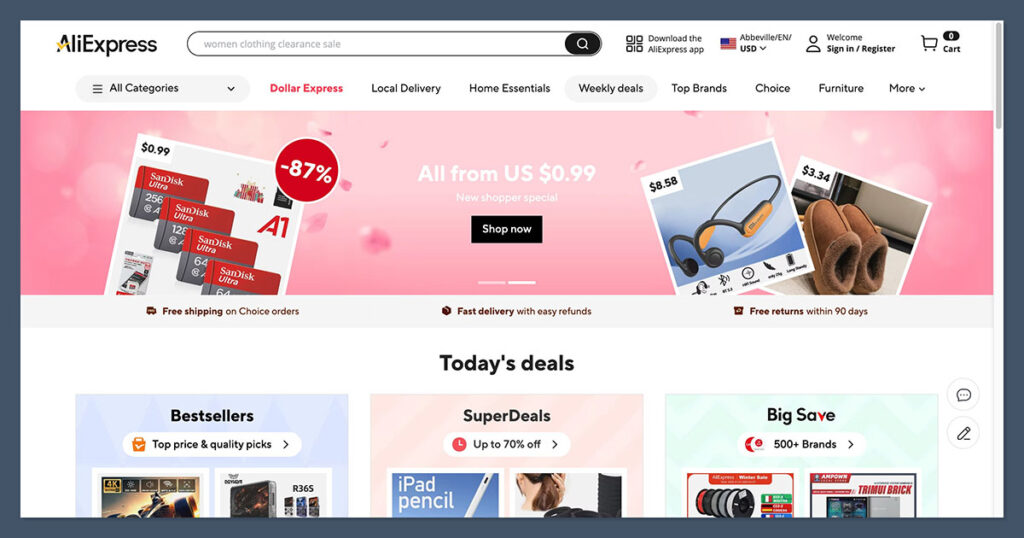Disclosure: We may earn a commission or fee from some of the links in our content. However, this does not affect our recommendations. Learn more.
AliExpress, one of the most widely used product sourcing platforms for dropshipping and print-on-demand businesses, supports a variety of payment methods.
Whether you’re fulfilling ten orders a week or hundreds per day, choosing the right payment method isn’t just about convenience—it can affect your margins, refunds, automation, and cash flow.
In this guide, I’ll walk you through the main AliExpress payment options available in 2025, break down their pros and cons, and explain how each one fits into a growing ecommerce operation.
Pros and Cons of AliExpress Payment Methods
Here’s a snapshot of the pros and cons you’ll want to keep in mind when choosing your preferred payment method on AliExpress:
Pros
- Accepts all major credit/debit cards, including Visa and Mastercard
- AliPay integration allows for quicker checkouts and refund handling
- Automation-friendly payment workflows for tools like DSers and AutoDS
- Multiple regional options available (Sofort, Boleto, iDeal, etc.)
- No extra platform fee for most payment methods
- Strong buyer protection via both AliExpress and card providers
Cons
- PayPal support is limited and not available in all countries
- Currency conversion fees can apply depending on your bank
- Refund times vary significantly by payment method
- Bank transfers are slow and not ideal for most dropshipping workflows
- Chargeback resolution is time-consuming, especially without proper documentation
Available Payment Methods on AliExpress in 2025

AliExpress supports a wide variety of payment methods, but availability depends on your location, currency, and sometimes order volume.
Here’s a breakdown of the most commonly used methods:
| Payment Method | Supported Globally | Works with Automation | Refund Time (Avg) | Notes |
|---|---|---|---|---|
| Visa / Mastercard | Yes | Yes | 7–15 days | Most commonly used by dropshippers |
| AliPay | Yes | Yes | 3–7 days | Native AliExpress option; fast and secure |
| PayPal | Limited (26 countries) | No | 5–10 days | Not automation-compatible |
| American Express | Limited | Yes | 7–15 days | High processing fees in some regions |
| Bank Transfer (Wire) | Yes | No | 10–20 days | Suitable for high-volume bulk orders |
| Apple Pay | US + iOS only | No | 7–10 days | Device-restricted |
| Google Pay | Android only | No | 7–10 days | Browser and device-dependent |
| Klarna / Afterpay | EU / US only | No | 5–8 days | Split payment option for customers |
| Regional Options (Sofort, Boleto, iDeal, Qiwi) | Country-specific | No | Varies | Works well locally |
Note: Not every supplier on AliExpress supports every payment method. Some may only accept card payments or AliPay.
My Recommended Payment Setup for Dropshippers
Based on my own experience managing multiple stores, I recommend using Visa or Mastercard credit cards, connected directly to your AliExpress account.
This setup is automation-friendly and integrates smoothly with tools like DSers, AutoDS, and Dropified.
Why Credit Cards Work Best:
- They’re compatible with order automation tools
- Offer fraud protection and chargeback capabilities
- Many provide cashback or points, improving your net margin
- Faster order processing compared to bank transfers or PayPal
To keep things organized, I use virtual business cards from providers like Wise or Payoneer, assigning one per store to track expenses separately.
AliPay: A Closer Look
AliPay is the in-house digital wallet from Alibaba Group and is fully integrated into the AliExpress checkout system.
If you’re doing consistent volume on AliExpress, it’s worth considering.
AliPay Benefits:
- Faster payment processing and refunds
- Full integration with your AliExpress account
- Keeps transactions centralized
- Offers similar protection to a credit card
- Works with saved cards and local payment gateways
However, AliPay does require identity verification (KYC), which can take 24–48 hours to complete. It’s a one-time process, but something to be aware of if you’re setting up a new account.
What About PayPal?
PayPal is available on AliExpress—but only in select countries and not across all sellers.
Limitations to Be Aware Of:
- No integration with automation tools (DSers, AutoDS, etc.)
- Higher processing fees compared to cards (typically 3.5%+)
- Slower refund processing (especially for chargebacks)
- Not available in every country or from every supplier
If you already use PayPal heavily in your business, you can try using it on AliExpress, but I don’t recommend it as your primary method if you’re looking to automate or scale.
Payment Automation: A Must for Scaling
Manually processing every order isn’t sustainable once you hit more than 10 orders per day. That’s where automation comes in.
Tools That Support Payment Automation:
| Tool | Payment Support | Notes |
|---|---|---|
| DSers | Credit Cards, AliPay | Official AliExpress partner |
| AutoDS | Credit Cards | Multi-supplier integration |
| Dropified | Credit Cards | More flexibility for advanced sellers |
These tools allow you to:
- Store your card safely in AliExpress
- Place orders automatically once a customer purchases from your store
- Track order numbers and shipping details
- Send automated tracking updates to your customers
This saves hours each week and ensures your orders are fulfilled faste
Refunds and Disputes
Knowing how refunds work with each payment method is key. AliExpress does have buyer protection in place, but timelines vary.
Refund Processing Times
| Payment Method | Refund Time | Refund Goes To |
|---|---|---|
| Visa/Mastercard | 7–15 days | Back to card |
| AliPay | 3–7 days | Wallet/card |
| PayPal | 5–10 days | PayPal balance |
| Bank Transfer | 10–20 days | Bank account |
Tips for Faster Refunds:
- Always open a dispute before the buyer protection window ends
- Include screenshots, tracking info, or proof of issue
- Avoid switching cards or closing accounts mid-refund
It’s also helpful to monitor the status of your refund within the AliExpress dispute center, as updates are usually posted there before any money hits your account.
If a refund is marked as “processed,” that means AliExpress has released the funds, but the delay is likely with your bank or card processor.
Fees, Conversion Costs, and Currency Charges
AliExpress processes payments primarily in USD, even if your card is in another currency.
Depending on your bank or card issuer, this may result in foreign transaction fees, typically ranging from 1% to 3% per order.
Ways to Avoid Extra Charges:
- Use a USD-based business card
- Choose a card with no foreign transaction fees
- Use Wise or Revolut Business to convert currencies at better rates
This becomes important as your order volume grows, especially if you’re operating at low margins.
If you’re selling in currencies other than USD but paying AliExpress in USD, this also introduces conversion mismatches on your profit tracking.
To stay accurate, I recommend using accounting tools or spreadsheets that account for both currency exchange and transaction fees, so you know exactly how much each product costs and what your true margins are after fees.
Payouts and Chargebacks
AliExpress doesn’t “payout” to you unless you’re a supplier.
But understanding how refunds and chargebacks affect your business is still important.
Chargeback Considerations:
- Most credit cards allow chargebacks within 120 days
- Chargebacks can take 2–6 weeks to resolve
- You’ll need clear documentation (e.g. supplier conversation, tracking info)
- Too many chargebacks can get your card blocked
If you use PayPal and get a chargeback, it’s processed via PayPal’s internal system—but again, resolution can be slower.
Keep in mind that AliExpress has its own dispute process, which is usually sufficient for resolving most order issues without escalating to a chargeback.
Only file a chargeback with your bank or PayPal if you’ve exhausted all internal options on AliExpress.
Who Should Use Which Payment Method?
To help you decide, here’s a quick overview based on business size and model:
| Business Type | Recommended Payment Method |
|---|---|
| New dropshipping store (<50 orders/month) | Credit or debit card (Visa/Mastercard) |
| Scaling store (50–500 orders/month) | Business credit card + DSers |
| POD with fewer suppliers | AliPay or DSers + card |
| High-volume or B2B buyers | Bank transfer + bulk orders |
| Multi-store operators | Virtual cards via Wise or Payoneer |
If you’re transitioning from a personal project to a full-time business, this is a great time to revisit your payment setup.
Many new sellers stick with personal cards or PayPal for too long, and it can cause headaches down the line with accounting, disputes, or spending limits.
Upgrading to business-grade payment tools early can save time and reduce stress as your order volume scales.
Final Verdict: What’s the Best Way to Pay on AliExpress in 2025?
For most dropshipping and POD sellers, the best payment method on AliExpress is a Visa or Mastercard business credit card, saved within your account and integrated into an automation tool like DSers.
AliPay is a close second, especially if you’re managing everything within the AliExpress ecosystem and want a cleaner interface.
While PayPal and bank transfers have their place, they’re not ideal for most ecommerce sellers in 2025.
To summarize:
- Use credit cards for automation, speed, and protection
- Set up AliPay if you want better refund handling
- Avoid PayPal unless it’s your only option
- Don’t use wire transfers unless you’re doing bulk, wholesale-style orders
While no payment method is perfect, choosing the right one for your dropshipping business gives you control, scalability, and peace of mind.
It also opens the door to smarter financial tracking and cost-saving opportunities as you grow.

